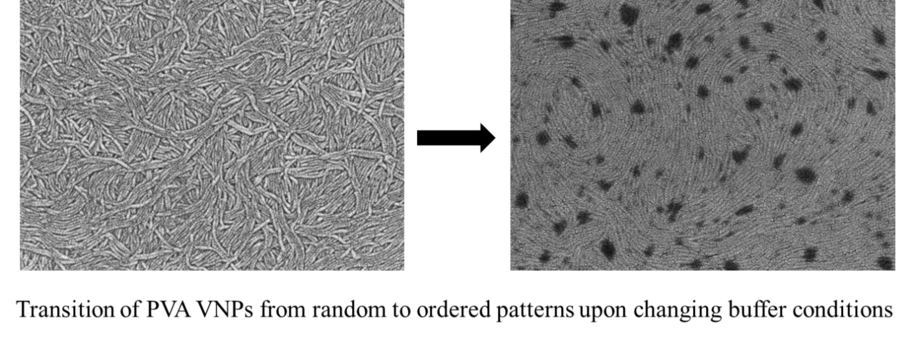From Light to Motion: Shaping surfaces with light
Multifunctional Materials Design group: A quantitative study that leads to a more precise control of the photoactive surface

Full title of the project: Super-stretchable functionalized materials and fibers for third generation wearable technology (Academy of Finland Research Project)

Multifunctional Materials Design group: A quantitative study that leads to a more precise control of the photoactive surface

Researchers from the Multifunctional Materials Design research group created a hierarchical structure made up of micro- and nanoscale pores

Researchers at Aalto University have discovered a way to convert polysaccharides from biowaste into a material that can outperform glass wool and other commercially used sound absorption materials with similar thickness.
According to the European Parliament Science and Technology Options Assessment Panel, wearable technology will transform our lives. This research will tackle two of the main barriers hindering its use, namely limited deformability and the lack of autonomous power production. We will develop highly-stretchable functional textile fibers that monitor both the body biomarkers and mechanical surface deformations of their substrates. Moreover, we will design hierarchical surfaces suitable for super-stretchable electrodes that will be applied as components for stretchable organic solar cells.
The keys for success are (i) to deposit well-defined nanostructures directly on textile fibers; (ii) to design such elastomeric materials that can indicate mechanical actions with absorption colour or fluorescence emission changes; and (iii) to increase the surface area in rigid templates (metal and transparent conductive oxide electrodes) that can be lifted-off onto stretchable substrates. The stretching capacity of these functional materials and devices is crucial for their integration into irregularly curved or moving surfaces, and for their durability under external stress.
The proposed preparation methods, such as light-assisted dip-coating and flow-coating, can be scaled up from bench-top fabrication to industrial scale, such as roll-to-roll production. Moreover, these methods need minimum amount of raw materials and their waste production is as low as possible, in order to advance the resource-wise circular economy in society. Thus, the wearable technologies researched in this project will promote a paradigm shift towards more sustainable third generation wearables that integrate functional devices seamlessly into textiles and clothing.
"Ability to control the assembly of building blocks in an organized manner is an extremely powerful tool for fabrication of nano-to-large scale functional structures. Self-templated ordered structures can augment functional performance by summing unit properties like magnetic/piezoelectric strength or exhibit completely unprecedented properties like structural color, surface plasmon resonance etc., which are not inherently present in the individual units. Virus particles in this context are naturally occurring nanoparticles that often reported to demonstrate self-assembly behavior.
Plant virus-based nanoparticles are ‘green’, renewable and completely non-toxic to humans. Owing to their ease of production and functionalization, plant viruses prove to be excellent building blocks for fabrication of functional nano-structures. Moreover, if we consider their monodispersity and uniformity in terms of composition, size and shape, no commercially available rod-like colloid or polymer can compete with them in this regard. Potyviruses (in our case, potato virus A, shortened as PVA) particles (VNPs) are very flexible high aspect ratio rods with interesting self-assembly properties. In this project, we will explore self-assembly behavior of PVA in detail and identify the factors governing the emergent assembly patterns. In addition, we will also design and optimize techniques for uniformly coating textile fibers with PVA VNPs. Finally, we will integrate this knowledge to produce ‘smart’ yarn materials for wearable technical textile."

"My current work is focused on combining the azobenzene-based supramolecular complexes with the stretchable substrate to build a double-layered structure, which could generate the wrinkle structure upon stretching. Under the light illumination, the wrinkle structure can be erased, and the rate of erasure is tunable by adjusting the azobenzene content or changing the azobenzene component. Furthermore, this azo-contained wrinkle system exhibits both photo-responsive property and larger surface area, which can be further utilized for deposition and potential applications."
Subproject #1: Single-step methods for controlling the morphology of nanostructured thin films
"In this project, we study the effect of the withdrawal rate and solvent selectivity on the morphology evolution of dip-coated polystyrene-b-poly(ethylene oxide) thin films by applying a wide range of dip-coating speeds and altering the volume ratio of the tetrahydrofuran-water solvent system. Notably, we have obtained a hexagonally packed BCP pattern with long-range order without the need for post-annealing processes. Overall, a solid understanding of the parameters affecting the formed surface patterns and their interplay was attained and explained, extending the knowledge of this field to more materials."
Subproject #2: Chemical lift-off lithography for direct deposition of gold nanoparticles on top of nanostructured patterns
"In this study, we aim to deposit the nanostructured thin film with gold nanoparticles by either electrostatic interaction or chemical conjugation. The gold-decorated polymer template will then be measured in terms of LSPR signal. The project could potentially contribute to the ongoing development of bio-sensing devices and wearables."
Subproject #3: Multilevel hierarchical thin film
"A hierarchical porous film with different levels of pore sizes can be fabricated using a simple and one-step dip-coating method. The micro-size pores can be obtained using breath figure technique while the nano-size ones are resulted from the self-assembly of block copolymer."
Accountable project leader: Prof. Jaana Vapaavuori ([email protected])
Project team:
Swarnalok De, Postdoctoral Researcher ([email protected])
Yujiao Dong, Doctoral Candidate ([email protected])
Hoang M. Nguyen, Doctoral Candidate ([email protected])
Project page on the Research Aalto portal: SUPER-WEAR
Group led by Professor Jaana Vapaavuori

Recent MMD publications (Multifunctional Materials Design)

Recent MMD publications (Multifunctional Materials Design)
